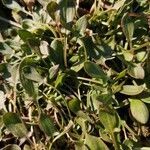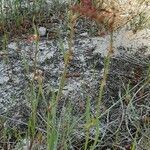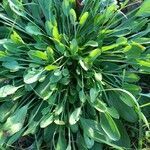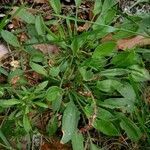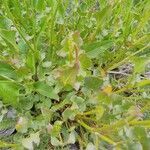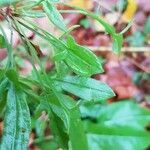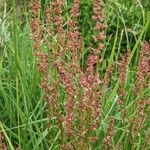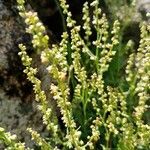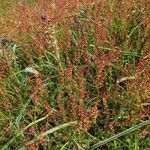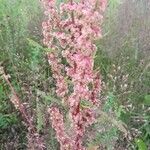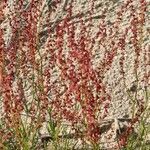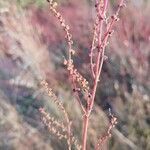Plants perennial, glabrous, with vertical rootstock and/or creeping rhizomes. Stems erect or ascend-ing, several from base, branched in distal 1/ 2 (in inflorescence), 10-40(-45) cm; shoots variable. Leaves: ocrea brownish at base, silvery and lacerated in distal 1/ 2; blade normally obovate-oblong, ovate-lanceolate, lanceolate-elliptic, or lanceolate, occasionally, linear-lanceolate to almost linear, 2-6 × 0.3-2 cm, base hastate (with spreading, entire or sometimes multifid, dissected lobes), occasionally without evident lobes, then base broadly cuneate, margins entire, flat or nearly so, apex acute or obtuse. Inflorescences terminal, usually occupying distal 2-3 of stem, usually lax and interrupted to top, broadly or narrowly paniculate. Pedicels 1-3 mm. Flowers (3-)5-8(-10) in whorls; inner tepals not or slightly enlarged, normally 1.2-1.7(-2) × 0.5-1.3 mm (free wing absent or barely visible), base cuneate, apex obtuse or subacute. Achenes brown or dark brown, 0.9-1.5 × 0.6-0.9 mm. 2n = 14, 28, 42.
Glabrous, dioecious perennial, generally somewhat reddish, sometimes ± hoary, often with an extensive system of slender, branching, yellow rhizomes with adventitious buds; flowering stems erect, c. 3-30 cm tall. Petiole slender, on lower lvs sometimes much > lamina. Lamina c. 1.5-5 × 0.2-2 cm, linear-oblong, lanceolate to elliptic, sour to taste, usually with a pair of lanceolate basal lobes at ± right angles to rachis, sometimes with a secondary lobe, or often entire in cauline lvs; apex obtuse to acute. Infl. usually reddish, sometimes yellowish, to c. 20 cm long, with slender branches, leafless or nearly so. Fls fascicled, on slender pedicels. Perianth of ♂ fls 1-2 mm long; margin hyaline. Outer perianth of ♀ fls 0.5-0.8 mm long, not reflexing; valves 1.2-1.5 mm long, entire, not tuberculate, not enlarging at fruiting, usually ± crimson, sometimes yellowish; margins acute. Nut 1.2-1.6 mm long, shining brown, obtusely angled.
A slender perennial, with erect or decumbent stems, seldom exceeding 30 cm. tall, arising from a basal tuft of leaves.. Ocreae hyaline, 4–5 mm. long, readily tearing.. Leaves long-petioled, hastate, often narrowly so, apically subacute, basally decurrent; the terminal lobe seldom exceeding 4 cm. in length; basal lobes much shorter, narrow, spreading outward and often turning forward; immature leaves often unlobed, linear.. Inflorescence slender, paniculate, much-branched, leafless; the flowers borne in close fascicles up to 5 mm. apart.. Male flowers 2–2.5 mm. across, the outer tepals oblong-lanceolate, partly appressed to the inner; inner tepals greenish-brown becoming tinged with red. Anthers yellow, 1 mm. long, longer than the filaments.. Inner tepals of ♀ flowers closely appressed to and accrescent with the nut; outer tepals small, lanceolate.. Nut light brown, sharply trigonous, ± 1 mm. long and approximately as broad.
Low delicate glabrous perennials with slender creeping rootstocks. Leaves glabrous, lanceolate-hastate, apically acute to rounded, 1-3 cm. long, 3-8 mm. broad; petioles 1-5 cm. long; ochreae mostly 0.5-1 cm. long, tardily deciduous. Inflorescences of panicles of remote few-flowered verticils. Flowers dioecious, on pedicels mostly less than 3 mm. long; outer tepals oblong to narrowly ovate, about 0.5 mm. long, scarcely accrescent; inner tepals broadly ovate, about 1 mm. long, scarcely accrescent, not tuberculate; stamens 6 discrete, the filaments less than 0.3 mm. long, the anthers 0.5-1 mm. long, bilocular and loculicidal; ovary trigonous, the 3 styles spreading, with 3 peltate fimbrillate stigmata. Achene triquetrous, brown, dull and rough, often slightly exserted, about 1 mm. long.
Dioecious perennial 1–4 dm from slender creeping roots; lvs variable, usually 3-lobed, the terminal lobe narrowly elliptic to oblong, the lateral much smaller, triangular, divergent; lf-base below the lobes truncate to long-cuneate; infl sometimes half the length of the shoot; pedicel jointed next to the fl; outer tep lanceolate; inner tep in male fls 1.5–2 mm, obovate, in female broadly ovate; achene 1.5 mm, shiny golden brown, closely invested by the valves; 2n=14, 28, 42. Fields, lawns, and waste places, in acid soils; native of Eurasia, naturalized throughout most of N. Amer., and highly variable.
A herb. It grows 10-25 cm tall. It keeps growing from year to year. It has a slender but wide-spreading rootstock. It has narrow leaves. They are sword shaped and smooth. The veins run length wise right along the leaf. It has curved, winged ears at the base of the leaf. The leaves are on long stalks. The seeding spikes are slender and yellow-green at first but become reddish-brown. The seeds are small and do not have spines or bristles.
Dioecious, rhizomatous perennial, up to 300 mm tall. Leaves often basally tufted, oblanceolate-hastate, long-petiolate, sheathing stipules conspicuous, silvery, papery. Flowers in axillary clusters on branched spikes, red, very small. Fruit small, up to 2 mm long, articulating at pedicel apex.
Dioecious, rhizomatous perennial to 30 cm. Leaves often tufted, oblanceolate-hastate, long-petiolate, stipules conspicuous, papery. Flowers in axillary clusters on branched spikes. Fruits small, to 2 mm long, articulating at pedicel apex.
